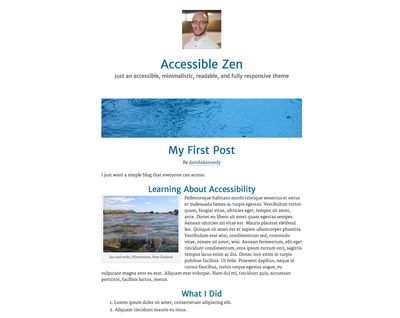Accessible Zen

Intro
Heads up! Accessible Zen isn’t in active development any longer. I learned a lot from the project. Thanks for your interest!
Accessible Zen is an accessible, minimalistic, readable, and fully responsive WordPress theme by David A. Kennedy. Inspired by Leo Babauta’s Zen Habits theme, Accessible Zen puts the focus on your content and nothing else, plus it has plenty of WordPress goodness built right in.
Download the latest version or view the demo.
Current Release: 1.2
Features
- Uses HTML5 with dashes of CSS3 for a future-friendly site.
- Has a mobile-first responsive design.
- Meets both Section 508 standards and Web Content Accessibility Guidelines, Level AA from the theme template perspective. This includes a carefully-choosen color scheme.
- Code based on Automattic’s Underscores WordPress theme to help ensure use of WordPress theme standards.
- Supports all modern browsers, plus Internet Explorer 7 and above.
- Has a simple one-column layout, and no main menu in the
headersection of the site so users can get to your content quickly. But it does include an invisible (visible on keyboard focus) skip link for screen reader and keyboard users. - Features the lovely Merriweather Sans and Merriweather.
- By default, Accessible Zen will display the site owner’s Gravatar in the header. You can replace this by uploading a Custom Header Image in Appearance -> Header, or you can remove it completely by selecting Remove Header Image.
- Features all nine post formats.
- Shows menus only when you need them. Accessible Zen doesn’t display a menu as a default to keep it as simple as possible. Of course, if your site needs a menu you can easily set up a Custom Menu in Appearance -> Menus. The theme features two menus, which display in the
footer - Tight integration with the WordPress Theme Customizer, allowing site owners to edit the theme’s appearance on the fly. They can show/hide the site description, display excerpts or full content on archive pages and more.
- Includes two page templates: an archives template, which features an archive of posts in different ways; a front page template, which allows site owners to feature content with unique styling. Plus, the page shows only one post by default, allowing users to focus on your latest and greatest content.
- Incorporates the font icon, Genericons in a few spots throughout the theme.
- Treats the WordPress except and Read More tag with care, and displays the post title so excerpts output like this:
Continue reading Post Title
Demo
View the Accessible Zen demo.
Documentation
In addition to this readme file, the documentation file (accessible-zen-documentation) provides details on how to use Accessible Zen’s features.
Inspiration and Thanks!
This theme would not be possible without the help of countless people. A sincere thanks to the web workers listed below for their inspiration, code and ideas!
- Leo Babauta and his Zen Habits theme. I love reading his blog, and the experience it provides.
- Automattic and all the contributors to the Underscores WordPress theme. I hope to contribute soon!
- Josh Hopkins and 40 Horse for their Fluid Baseline Grid, which helped me develop the theme quickly.
- The folks who have contributed to Genericons, the free, flexible icon font for blogs.
- Joeleen Kennedy for her endless encouragement and design feedback.
- The crew at Make WordPress Accessible because they’re so helpful and awesome. You should get involved!
The original Zen Habits 2 theme by Leo Babauta is uncopyrighted.
Underscores is licensed under the GNU General Public License.
The Fluid Baseline Grid is licensed under the Unlicense.
Genericons is licensed under the GNU General Public License.
Contribute
Why, hello there! This is an open source project, and you can help out in many ways.
Theme Users
Use the theme, and submit ideas for future enhancements. You can submit feedback on the GitHub issues section, the WordPress.org forums for this theme or by emailing me at me@davidakennedy.com.
Users with Disabilities
Visit the theme demo or any site running the theme, and provide any feedback regarding use of the theme from an assisitive technology standpoint. You can submit feedback on the GitHub issues section, the WordPress.org forums for this theme or by emailing me at me@davidakennedy.com.
Developers
Use the fork and pull model of GitHub. Fork the theme on GitHub and submit pull requests.
Changelog
View the changelog easily in the GitHub.com repository.
Remember
You’re awesome! Also, accessibility is more about people than technology. Anyone can make the web more accessible. Start learning how at WebAIM.